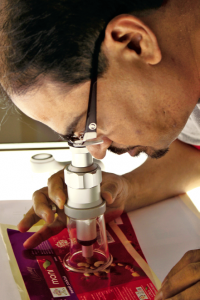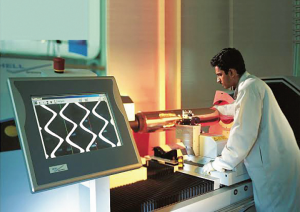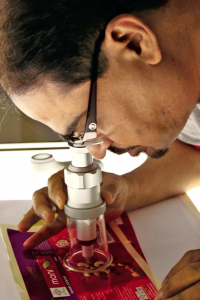While some commentators predict gravure will be squeezed out of packaging, Manoj Garg, general manager of GulfScan, Sharjah, tells Benjamin Daniel of Packaging MEA that the process is winning a rising share of Middle East markets.

BD: Would you agree that gravure printing has been losing out to CI flexo and rotary offset?
MG: In publishing printing in the 1980s in Europe and America, gravure slowly lost its dominance as processes such as web offset and flexo tremendously improved their quality and turnaround time.
But we need to view this specifically in packaging. Gravure and flexo continue to compete head-to-head in packaging, particularly flexible packaging, and their relative market share varies greatly according to where in the world the comparison is made.
BD: How do world regions compare?
MG: Gravure printing predominates in flexible packaging in the Middle East and Africa and has lost little to CI flexo or rotary offset.
In Asia-Pacific, the ratio of flexo to gravure is 20:80, whereas in Europe it is 55:45, and North America 75:25. So gravure is slowly losing its share to CI flexo and rotary in specific regions: the trend is not general.
Consumer marketing and retailing is changing from massmarketing to more specific matching of product packaging to consumer characteristics, resulting in shorter runs, a trend more prevalent in European and American markets and obviously favouring flexo over gravure.

flexo continue to compete head-to-head in packaging, particularly
flexible packaging”
BD: What else drives these differing figures?
MG: In Asia, cylinder processing, thanks to lower labour costs, is significantly cheaper than in the US.
Moreover, in the US, investments in modern gravure equipment have been slow. This is evidenced by high cylinder costs, more than 100% above European and more than 200% above the cost in Asia.
Holding on to a 50% packaging printing share of the European market, gravure has defended and strengthened its market share, in spite of environmental regulations and higher quality flexo outputs.
Particularly in packaging production for large brand owners and retail chains, gravure is going strong. The same trend is seen in Asia as well.
BD: What about the Middle East and Africa?
MG: In the Middle East and Africa, in the main category of flexible packaging, gravure continues to dominate and grow. Wide-web flexo is growing and gaining traction, but not as vigorously as one might expect.
The main reason is that gravure is still seen as the superior and easy-to-use technology with high-quality electronically or laser engraved cylinders. It is still considered as the practical solution for reverse printing and lamination for creating various barrier properties.
Wide-web CI flexo scores well for films that will be surface printed, and especially for thinner and extensible films. With highly expert prepress and the use of certain over-varnishes, flexo matches and can even exceed gravure quality.
But it is this extra skill and expertise, together with the higher cost of automated CI flexo presses, that seem to keep its growth in check.
While CI wide-web flexo is growing in the region, rotogravure seems to grow more robustly and on a much higher installed base.
CI flexo is getting stronger only with some specific substrates.
BD: In the MEA, how do flexo and gravure compare in cost and quality?
MG: The USP of gravure, its excellent quality and high consistency even with very high print runs, naturally favours gravure in this region, where brand owners prefer gravure to print their packages, as only gravure guarantees consistent quality.
The appearance of packaging plays the decisive role in the competition on the shelves of the fastest growing consumer markets.
Also, flexography no longer has a cost advantage. As flexography has improved its quality over recent years, it has become more expensive and lost much of its previous cost advantage.
Brand owners now have a wider choice over printing process keeping in mind their target audiences and positioning of product on the shelf.
BD: What is the future for gravure?
MG: The future of gravure is highly secure. Press speeds will become even faster. Print tolerances will move to microns. Changeover times will continue to decrease. Gravure presses will become platforms to accept whatever process is best for the printer’s target market.
The installed capacity of gravure is growing more than CI flexo, further strengthening the dominance of gravure in the region.

BD: Could developments in HD flexo and CI flexo alter this outlook?
MG: Historically, flexographic printing has had its drawbacks, the most cited being inconsistency between production runs, primarily due to the quality of flexo plates.
This problem, however, has been reduced and better controlled over time thanks to technological developments.
In recent years, many advances have been made in all component elements used in the printing process, such as anilox rollers, ink, photopolymer plates, mounting tape and flexographic printing press design, bringing about a rise in quality and hence increased uptake.
Most of all, the process became measurement based, data driven and predictable. Apart from this, flexo prepress has also taken big leaps forward such as HD flexo.
So flexo has started dominating in segments such as narrow web label presses, stack flexo presses and corrugated presses. Narrow web presses are increasingly looked at for printing on unsupported films and for lami-tubes. Narrow web flexo presses are also beginning to be used for producing mono-cartons.
However, the growth in CI flexo is comparably still slow.
Undoubtedly it can now compete with offset for quality labels and with gravure for flexible packaging. But in flexible packaging, wideweb flexo’s growth is slow, whereas gravure is surging ahead and stealing a sizeable share of the pie.
BD: How do you see the outlook for flexible packaging generally in the MEA?
MG: With a population of 1.2bn in the Middle East and Africa, flexible packaging has the same growth potential here as it has in India.
Major investment in the food sector has further strengthened its position, because food packaging accounts for 80% of flexible packaging.
Rising consumer demand for packaged dried and dehydrated food such as pasta, rice, milk powder and soup mixes and growing numbers of young consumer in the region have also boosted demand for flexible packaging.
Another strong indicator for its growth comes from reasonable cost, versatility and potential for innovation. In addition, emerging markets in the region including the UAE, Saudi Arabia, South Africa and Nigeria are going to consume more, due to rising disposable income.
All these factors increase the use of high-quality flexible packaging, giving gravure printing an indirect boost.



